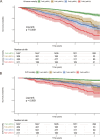Associations of frailty and cognitive impairment with all-cause and cardiovascular mortality in older adults: a prospective cohort study from NHANES 2011-2014
- PMID: 39987017
- PMCID: PMC11846165
- DOI: 10.1186/s12877-025-05752-9
Associations of frailty and cognitive impairment with all-cause and cardiovascular mortality in older adults: a prospective cohort study from NHANES 2011-2014
Abstract
Background: The global aging trend exacerbates the challenge of frailty and cognitive impairment in older adults, yet their combined impact on health outcomes remains under-investigated. This study aims to explore how frailty and psychometric mild cognitive impairment (pMCI) jointly affect all-cause and cardiovascular disease (CVD) mortality.
Methods: The cohort study we examined 2,442 participants aged ≥ 60, is the secondary analysis from the National Health and Nutrition Examination Survey (NHANES) 2011-2014. Frailty was quantified using a 49-item frailty index, while pMCI was determined by three composite cognition scores one standard deviation (SD) below the mean. The associations between frailty, pMCI, comorbidity, and mortality were assessed using weighted Cox proportional hazards models.
Results: Of the participants, 31.37% were frail, 17.2% had pMCI, and 8.64% exhibited both conditions. The cohort was stratified into four groups based on frailty and pMCI status. After a median follow-up period of 6.5 years, frail individuals with pMCI had the highest all-cause (75.23 per 1,000 person-years) and CVD (32.97 per 1,000 person-years) mortality rates. Adjusted hazard ratios (HRs) for all-cause (3.06; 95% CI, 2.05-4.56) and CVD (3.8; 95% CI, 2.07-6.96) mortality were highest in frail older adults with pMCI compared to those who were non-frail without pMCI.
Conclusion: Our study highlights the ubiquity of frailty and cognitive impairment in older adults and underscores the heightened risk of mortality associated with their coexistence. These findings suggest the critical need for proactive screening and management of frailty and cognitive function in clinical practice to improve outcomes for the older adults.
Keywords: Cognition; Frailty; Mortality; Older adults; Psychometric mild cognitive impairment.
© 2025. The Author(s).
Conflict of interest statement
Declarations. Ethics approval and consent to participate: The investigation was approved by the NCHS research ethics review board. Consent for publication: Not applicable. Competing interests: The authors declare no competing interests.
Figures



References
-
- Hoogendijk EO, Afilalo J, Ensrud KE, Kowal P, Onder G, Fried LP. Frailty: implications for clinical practice and public health. Lancet. 2019;394(10206):1365–75. - PubMed
-
- Dent E, Martin FC, Bergman H, Woo J, Romero-Ortuno R, Walston JD. Management of frailty: opportunities, challenges, and future directions. Lancet. 2019;394(10206):1376–86. - PubMed
-
- Fried LP, Tangen CM, Walston J, Newman AB, Hirsch C, Gottdiener J, Seeman T, Tracy R, Kop WJ, Burke G, et al. Frailty in older adults: evidence for a phenotype. J Gerontol Biol Sci Med Sci. 2001;56(3):M146–156. - PubMed
MeSH terms
Grants and funding
LinkOut - more resources
Full Text Sources
Medical

